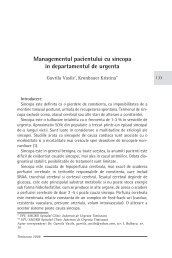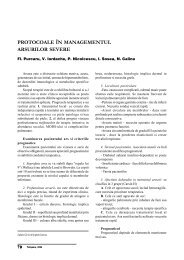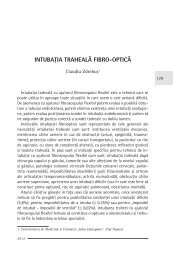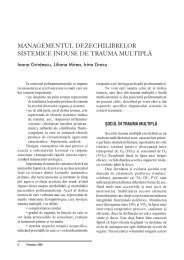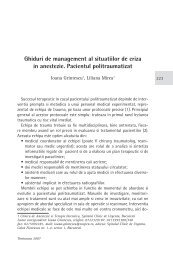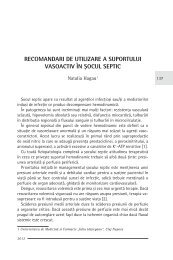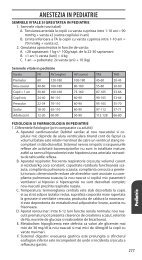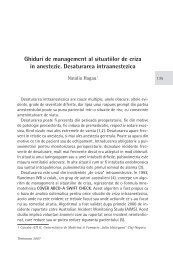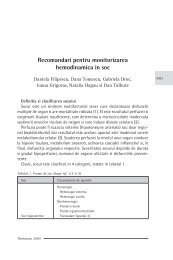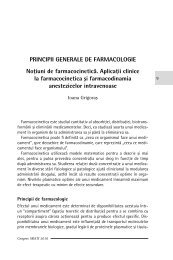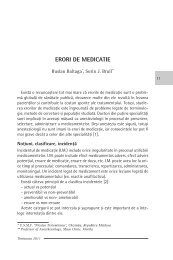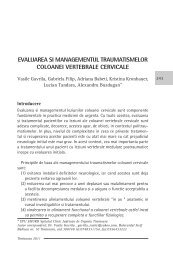Algoritm de diagnostic si tratament in infectiile fungice in
Algoritm de diagnostic si tratament in infectiile fungice in
Algoritm de diagnostic si tratament in infectiile fungice in
Create successful ePaper yourself
Turn your PDF publications into a flip-book with our unique Google optimized e-Paper software.
<strong>in</strong>suficienţă <strong>de</strong> organ, faţă <strong>de</strong> procentul <strong>de</strong> 32% pentru<br />
cei cu analgezie epidurală. De asemenea, mortalitatea<br />
perioperatorie a fost mai mare (4 <strong>de</strong>cese versus 0<br />
pentru grupul cu epidurală).<br />
Tuman şi colaboratorii 15 au evaluat <strong>in</strong>teracţiunea<br />
d<strong>in</strong>tre anestezia epidurală, statusul coagulării şi evoluţia<br />
<strong>de</strong> după <strong>in</strong>tervenţia chirurgicală <strong>de</strong> revasculare<br />
a membrelor <strong>in</strong>ferioare; la unii pacienţi s-a aplicat<br />
anestezie generală şi analgezie epidurală postoperatorie,<br />
iar la alţii s-a aplicat anestezie generală şi i.v.-PCA.<br />
Grupul cu epidurală a beneficiat <strong>de</strong> o durată mai<br />
scurtă <strong>de</strong> şe<strong>de</strong>re în STI şi <strong>de</strong> o reducere a complicaţiilor<br />
cardiovasculare şi <strong>in</strong>fecţioase. De asemenea,<br />
pacienţii cu analgezie epidurală au prezentat o<br />
<strong>in</strong>ci<strong>de</strong>nţă mai redusă a <strong>in</strong>tervenţiilor chirurgicale<br />
repetate pentru perfuzie tisulară <strong>in</strong>a<strong>de</strong>cvată.<br />
În concluzie, se poate statua că anestezia şi<br />
analgezia epidurală au un efect favorabil asupra<br />
evoluţiei postoperatorii.<br />
BIBLIOGRAFIE<br />
1. Rawal N. 10years of acute pa<strong>in</strong> service – achievements and<br />
challenges. Reg Anesth Pa<strong>in</strong> Med 1999; 24:68-73.<br />
2. S<strong>in</strong>atra R. Acute pa<strong>in</strong> management and acute pa<strong>in</strong> service. In:<br />
Cou<strong>si</strong>ns M, Bri<strong>de</strong>nbaugh P, eds. Neural Blocka<strong>de</strong> <strong>in</strong> Cl<strong>in</strong>ical<br />
Anesthe<strong>si</strong>a and Management of Pa<strong>in</strong>, Phila<strong>de</strong>lphia,<br />
USA,Lipicontt-Raven, 1998, p.793-835.<br />
3. Kehlet H, Wilmore DW. Multi-modal strategies to improve<br />
surgical outcome. Am J Surg 2002; 183:630-41.<br />
4. Macrae WA, Davies HTO. Chronic postsurgical pa<strong>in</strong>,<br />
<strong>in</strong>:Epi<strong>de</strong>miology of Pa<strong>in</strong>, Crombie IK, et al. (eds), IASP Press<br />
1999, Seattle, p.125-42.<br />
5. Perk<strong>in</strong>s KM, Kehler H. Chronic pa<strong>in</strong> as outcome of surgery. A<br />
review of predictive factors. Anesthesaiology 2000; 93:1123-<br />
33.<br />
6. Macrae WA. Chronic pa<strong>in</strong> after surgery. Br J Anesth 2001; 87:88-<br />
98.<br />
7. Blyth FM, March LM, Barnabie AJM, et al. Chronic pa<strong>in</strong> <strong>in</strong><br />
Australia: a prevalence study. Pa<strong>in</strong> 2001; 89:127-34.<br />
8. NHMRC. Acute pa<strong>in</strong> management: scientific evi<strong>de</strong>nce. NHRMC:<br />
Government Pr<strong>in</strong>t<strong>in</strong>g Office, 1998.<br />
9. Siddall PJ Taylor DA, McClelland JM, Rutkowski SB, et al. Pa<strong>in</strong><br />
report and the relationship of pa<strong>in</strong> to phy<strong>si</strong>cal factors <strong>in</strong> the first<br />
6 month follow<strong>in</strong>g sp<strong>in</strong>al cord <strong>in</strong>jury. Pa<strong>in</strong> 1999; 81:187-97.<br />
10. Siddall PJ Molloy AR, Walker S, Mather LE, Rutkowski SB,<br />
Cou<strong>si</strong>ns MJ. Efficacy of <strong>in</strong>trathecal morph<strong>in</strong>e and clonid<strong>in</strong>e<br />
<strong>in</strong> the treatment of pa<strong>in</strong> follow<strong>in</strong>g sp<strong>in</strong>al cord <strong>in</strong>jury. Anesth<br />
Analg 2000;91:1493-8.<br />
11. Gehl<strong>in</strong>g M, Scheidt C, Nichergall H, et al. Per<strong>si</strong>stent pa<strong>in</strong> after<br />
trauma surgery. Acute Pa<strong>in</strong> 1999; 2:110-4.<br />
12. Basbaum AI. Sp<strong>in</strong>al mechanism of acute and per<strong>si</strong>stent pa<strong>in</strong>.<br />
Reg Anesth Pa<strong>in</strong> Med 1999; 24:59-67.<br />
13. Sandkuhler J. Learn<strong>in</strong>g and memory <strong>in</strong> pa<strong>in</strong> pathways. Pa<strong>in</strong><br />
2000; 88:113-8.<br />
14. Millan MJ. The <strong>in</strong>duction of pa<strong>in</strong>: an <strong>in</strong>tegrative review. Prog<br />
Neurobiol 1998; 57:1-164.<br />
15. L<strong>in</strong>ton SJ. A review of psychological risk factors on back and<br />
neck pa<strong>in</strong>. Sp<strong>in</strong>e 2000; 25:148-56.<br />
16. Callesen T, Bech K, Kehlet H. Prospective study of chronic<br />
pa<strong>in</strong> after gro<strong>in</strong> hernia repair. Brit J Surg 1999; 86:1528-31.<br />
17. Chapman CR, Gavr<strong>in</strong> J. Suffer<strong>in</strong>g: the contributions of per<strong>si</strong>stent<br />
pa<strong>in</strong>. Lancet 1999; 353:2233-7.<br />
18. Nielson WR, Mior S. Prevention of chronic pa<strong>in</strong>: The<br />
unexplored frontier. The Cl<strong>in</strong>ical Journal of Pa<strong>in</strong> 2001; 17:S68-<br />
S69.<br />
19. Carr DB, Goudas LC. Acute pa<strong>in</strong>. Lancet 1999; 353:2051-58.<br />
20. Katz J, Jakson M, Kavanagh BP, et al. Acute pa<strong>in</strong> after thoracic<br />
surgery predicts long-term post-thoracotomy pa<strong>in</strong>. Cl<strong>in</strong> J Pa<strong>in</strong><br />
1996; 12:50-55.<br />
21. Tasmuth T, Kataja M, Blomqvist C, et al. Treatment related<br />
factors predispo<strong>si</strong>ng to chronic pa<strong>in</strong> <strong>in</strong> patients with breast<br />
cancer a multivariate approach. Acta Oncologica 1997;<br />
36:625-30.<br />
22. Gehl<strong>in</strong> M, Scheidr CE, et al. Per<strong>si</strong>stent pa<strong>in</strong> after trauma surgery.<br />
Acute Pa<strong>in</strong> 1999; 2:110-14.<br />
23. Callesen, Bach, Kehler H. Prospective study of chronic pa<strong>in</strong><br />
after hernia repair. British J Surgery 1999; 86:1528-615.<br />
24. Nikolajen L, Ilkjaer S, Kroner K, et al. The <strong>in</strong>fluence of<br />
preamputation pa<strong>in</strong> on postamputation stump and phantom<br />
pa<strong>in</strong>. Pa<strong>in</strong> 1997;72:393-405.<br />
25. Co<strong>de</strong>rre TJ, Katz J, Vaccar<strong>in</strong>o AL, et al. Contribution of central<br />
neurolpasticity to pathological pa<strong>in</strong>: review of cl<strong>in</strong>ical and<br />
experimental evi<strong>de</strong>nce. Pa<strong>in</strong> 1993; 52:259-85.<br />
26. Woolf CJ, Salter MW. Neuronal plasticity: <strong>in</strong>crea<strong>si</strong>ng the ga<strong>in</strong><br />
<strong>in</strong> pa<strong>in</strong>. Science 2000; 288:1765-9.<br />
27. Watk<strong>in</strong>s JR, Miligan ED, Maier SF. Glial activation: a driv<strong>in</strong>g<br />
force for pathological pa<strong>in</strong>. Trends <strong>in</strong> Neuroscience 2001;<br />
24:450-5.<br />
28. Kiddd BL. Urban LA. Mechanisms of <strong>in</strong>flammatory pa<strong>in</strong>. Br J<br />
Anesth 2001; 87:3-11.<br />
29. Cou<strong>si</strong>ns MJ, Power I, Smith G. Pa<strong>in</strong> - A per<strong>si</strong>stent Problem. Reg<br />
Anesth Pa<strong>in</strong> Med 2000; 25:6-21.<br />
30. Carr DB, Cou<strong>si</strong>ns MJ. Sp<strong>in</strong>al route of analge<strong>si</strong>a: oipiods and<br />
future options. In: Cou<strong>si</strong>ns MJ, Bri<strong>de</strong>nbaugh PO (Eds). Neural<br />
Blocka<strong>de</strong> <strong>in</strong> Cl<strong>in</strong>ical Anesthe<strong>si</strong>a and Management of Pa<strong>in</strong>, 3rd<br />
ed. Phila<strong>de</strong>lphia: Lippicott-Raven, 1998.<br />
31. Basbaum AI. Sp<strong>in</strong>al Mechanism of acute and per<strong>si</strong>stent pa<strong>in</strong>.<br />
Reg Anesth Pa<strong>in</strong> Med 1999; 24:56-67.<br />
32. Samad TA, et al. Trends Mol Med 2002; 8:390-6.<br />
33. Woolf CJ, Costagian M. Proc Natl Acad Sci USA 1999;<br />
96:7723-30.<br />
34. Woolf CJ, Salter MW. Science 2000; 288:1765-9.<br />
35. Samad TA, et al. Nature 2001; 410:471-5.<br />
36. Millan MJ. The <strong>in</strong>duction of pa<strong>in</strong>: an <strong>in</strong>tegrative review. Prog<br />
Neurobiol 1998; 57:1-164.<br />
37. L<strong>in</strong>ton SJ. A review of psychological risk factors on back and<br />
neck pa<strong>in</strong>. Sp<strong>in</strong>e 2000; 25:1148-56.<br />
38. Ec. Patient education and counsell<strong>in</strong>g 1992; 19:129-42.<br />
39. Jensen TS, Gottrup H, Gottrup J, et al.The cl<strong>in</strong>ical picture of<br />
neuropathie pa<strong>in</strong>. European Journal Pharmacology 2001;<br />
429:1-11.<br />
40. Stanos SP, Har<strong>de</strong>n RH, Wagner-Raphael R, et al. A prospective<br />
cl<strong>in</strong>ical mo<strong>de</strong>l for <strong>in</strong>vestigat<strong>in</strong>g the <strong>de</strong>velopment of CRPS, <strong>in</strong>:<br />
Har<strong>de</strong>n RN, Baron R, Janig W eds. Complex Regional Pa<strong>in</strong><br />
Syndrome. Progress <strong>in</strong> Pa<strong>in</strong> Research and Management,<br />
Seattle, IAPS-press, 2001, p.151-64.<br />
41. Kehlet H, Holte K. Effect of postoperative analge<strong>si</strong>a on surgical<br />
outcome. Br J Anaesth 2001; 87:62-72.<br />
42. Kehlet H. A multimodal approach to control postoperative<br />
patophy<strong>si</strong>ology and rehabilitation. BrJ Anaesth 1997; 78:606-<br />
17.<br />
43. Bisgard T, Kehlet H. Early oral feed<strong>in</strong>g after elective abdom<strong>in</strong>al<br />
surgery. What are the issues? Nutrition 2002; 18:944-8.<br />
44. Kehlet H, Wilmore DW. Multimodal strategies to improve<br />
surgical outcome. Am J Surg 2002; 183:30-641.<br />
45. Holte K, Kehlet H. Postoperative epidural analge<strong>si</strong>a and<br />
outcome – a research agenda, <strong>in</strong>:Tramer M (ed). Evi<strong>de</strong>ncebased<br />
results <strong>in</strong> anaeshe<strong>si</strong>a and analge<strong>si</strong>a, 2 nd ed., BMJ Medical<br />
Books 2003.<br />
46. Kehlet H, Dahl JB. The value of multimodal or balanced<br />
analge<strong>si</strong>a <strong>in</strong> postoperative pa<strong>in</strong> treatment. Anest Analg 1993;<br />
77:1048-56.<br />
47. Niv D, Devor M. Tran<strong>si</strong>tion from acute chronic pa<strong>in</strong>, <strong>in</strong>:<br />
Aronoff GM edt., Evaluation and treatment of chronic pa<strong>in</strong>,<br />
3rd ed., Baltimore, Williams & Wilk<strong>in</strong>s, 1998.<br />
48. Kis<strong>si</strong>n I. Preemptive analge<strong>si</strong>a. Anesthe<strong>si</strong>ology 2000; 93:1138-<br />
43.<br />
49. Carr DB. Preemptive analge<strong>si</strong>a implies prevention.<br />
Anesthe<strong>si</strong>ology 1996;85:1498-1499<br />
254<br />
254 Timi[oara, 2005




